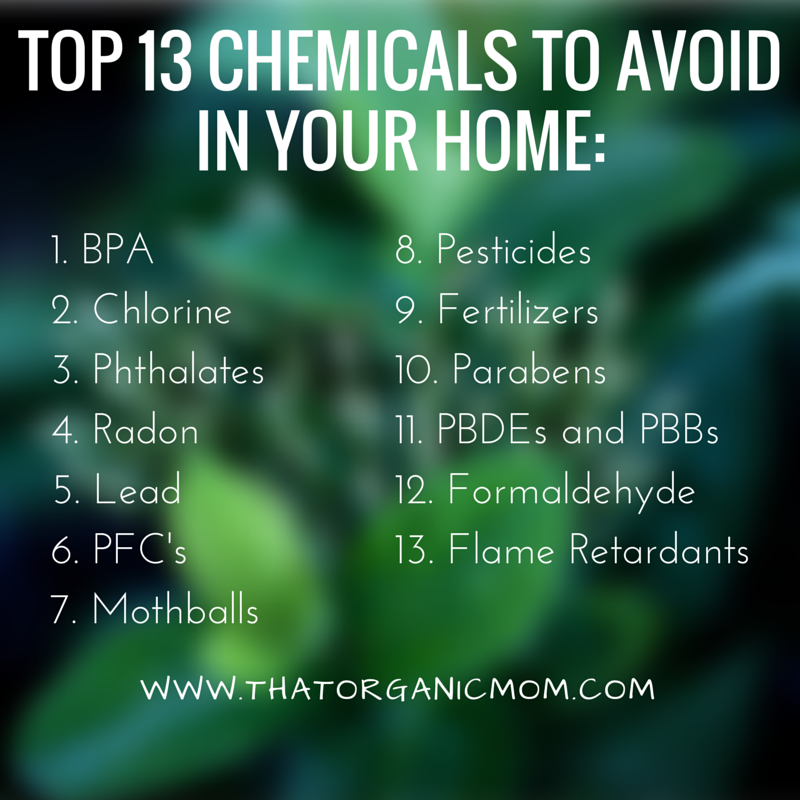Last Updated on September 7, 2022 by Rebecca Huff
Did you know that seventy-seven percent of poison exposure is unintentional? In other words, children being exposed to chemicals the parents thought were put safely away, or did not realize they needed to be. Poisoning is the second leading cause of home injury death. Sadly, poisoning leads to nearly 5,000 fatalities each year.
When you smell mothballs, you are inhaling the insecticide. The toxic mothball dissolves and releases poisonous vapors. Don't you hate the smell of mothballs anyways? Come on, admit it, you know it smells like “grandma's house.” Simply applying a drop of Peppermint Essential oil to a cotton ball will have the same effect. Here are some other tips on how to make the transition to a less toxic home.
- Look for food containers (and baby bottles) that clearly state they contain no BPAs. BPA has a structure very similar to estrogen and for that reason is referred to as a “hormone disruptor.” Hormone disruptors can interfere with the natural human hormones, especially for young children.
- Instead of chlorine bleach try using white vinegar. For whitening clothes, nothing beats sunlight!
- Phthalates go into many beauty products including hair spray, shampoos, fragrances, cosmetics and deodorants. Phthalates bind the color and fragrance in cosmetic products, and are also used to increase the durability and flexibility of plastics. Unfortunately, these hormone-like chemicals are linked to reproductive and developmental problems in animals. Because of these findings, California and Washington State have banned the use of phthalates in toys for younger children. Therefore, I too try to avoid them in products I use. Just look for labels that say “phthalate free.”
- Consider testing your home for Radon. Radon in your home can originate from a number of sources, including outside air that seeps into your home through cracks in the foundation, walls and floors, as well as your well water. Radon exposure can also come from certain building materials. Testing for Radon doesn't have to be expensive. Try a simple test such as First Alert RD1 Radon Gas Test Kit
. You mail it to the lab and results are usually back within 3 days.
- Lead is an obvious one, but do your research.
- Instead of carpet, opt for wood, tile or bamboo flooring if possible. Also, avoid stain- and water-resistant clothing, furniture and carpets to avoid perfluorinated chemicals (PFCs).
- For pests, like ants, etc. I like to use Boric Acid and/or Cinnamon oil. Seems to work fine for us.
- Fertilizers can easily be avoided. If you want a thick, green, beautiful yard, try using Epsom Salts! It's true!
- Many beauty products are available on the market now without parabens, so there's really no reason to use one that has this toxic chemical. Try your local health food shoppe. Check out some of the products in my store to see what I use around my house. Laundry detergents, lotion, etc. all toxic free found here.
- Avoid PBDE's and PBB's ESPECIALLY IF YOU ARE PREGNANT. The law does not require the use of toxic PBDE chemicals (polybrominated diphenyl ethers) to achieve this, but they are the cheapest way for manufacturers to meet the standard requirements. Upon testing blood levels of PBDEs in 25 second-trimester pregnant women in California, researchers found the highest ever reported levels in the world, sad right? They also found indications that the chemicals interfere with thyroid function, a finding that previous studies have also revealed. Sleeping on a toxic free mattress is ideal for parents AND children. Look for mattresses that are manufactured without the use of toxic chemicals like PBDE and PBB. Older adults should also avoid sleeping on mattresses with these chemicals as PBDEs disrupt mechanisms that are responsible for releasing hormones in your body, as well as alter calcium signaling in your brain, which is a critical mechanism for learning and memory.
- Formaldehyde is found in many types of paint. To avoid this chemical exposure, opt for paints with low VOC, we use ECOS Paints. Particleboard, fiberboard, and insulation often contain formaldehyde. Since you probably aren't going to renovate your entire home, try adding as many plants to your home as possible which help clean the air! Mattresses can also contain formaldehyde choose a toxin free, organic mattress for your family.
- Flame retardants are applied to furniture many times. Consider reupholstering your couch, replacing the foam and fabric. If this is cost prohibitive, use a vacuum with a HEPA filter and again, more plants!
- Check out my toxic free laundry room tour in this video
MORE TIPS ON How to prevent poisoning IN YOUR HOME
- Store cleaning products safely and out of reach of children. Opt for more natural products when purchasing cleaners.
- Do not use food containers as storage for hazardous materials.
- Clearly label all unmarked liquid containers, including “natural” products.
- Never mix household cleaning products together, especially bleach and ammonia (creates toxic gas).
- Be cautious when taking and storing medicines, read directions carefully and put away in a secure location right after use. I recommend using a lockbox for medications. Such as this one from Amazon.
- Monitor heaters and fireplaces. Make sure to have them cleaned every year before the cold weather months.
- Monitor children while in the kitchen. NEVER leave them unattended around stoves, microwaves or ovens because most poisonings occur while parents are cooking.
- Post the poison control center phone number in your kitchen (on the refrigerator, near the phone, and store it in your cell phone).
- Keep carbon monoxide outside (and monitor the levels in your home closely). I recommend installing a carbon monoxide detector.
Are there any subjects you have been wondering about which you would like me to write about in the future? If so, please leave your suggestions in the comments below. Have you read my classes on packing a healthy lunch box for your kiddos? If not, go HERE!



 Is Rosacea caused by liver congestion…
Is Rosacea caused by liver congestion…
Leave a Reply
You must be logged in to post a comment.